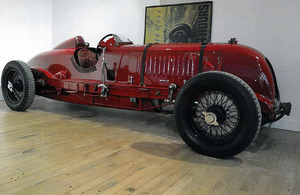Last chance to keep Birkin’s Bentley Blower, Jane Austen ring, Baines records and James Wolfe’s letters in the UK
Ed Vaizey places temporary export bars on 4 national treasures.

Bentley Blower image
Culture Minister Ed Vaizey took the decisions following recommendations by the Reviewing Committee on the Export of Works of Art and Objects of Cultural Interest (RCEWA), administered by Arts Council England.
Bentley Blower
The single-seater Bentley racing car known as a ‘Bentley Blower’, was originally designed, owned and raced by Sir Henry Birkin, one of the most effusive figures in British racing who enjoyed a super-star status comparable to that of some modern-day Formula 1 drivers. Birkin and the racer were the darlings of Brooklands, widely regarded as the heart of the pre-war motor racing scene in the UK. The car still holds the record for the fastest of all production-based racers at that track.
The temporary export bar placed on the Bentley provides a last chance to raise the £5,149,800 needed to keep it in the UK.
Bentley Blower image on Flickr
Jane Austen ring
The beautiful gold and turquoise ring is one of only 3 pieces of jewellery in existence known to have belonged to Jane Austen (1775-1817). The ring is accompanied by papers documenting its history within Jane Austen’s family, which reveal it passed firstly to her sister Cassandra, who then gave it to her sister-in-law Eleanor Austen, second wife of the Revd. Henry Thomas Austen (brother of Jane and Cassandra). It has remained in the family ever since. The temporary export bar placed on the ring provides a last chance to raise the £152,450 needed to keep it in the UK.
Jane Austen ring image on Flickr
James Wolfe archive
The archive is one of the most comprehensive series of letters from any significant military figure of the 18th century. James Wolfe, known as the ‘Hero of Quebec’ was a British Army officer remembered chiefly for his audacious victory over the French at the Battle of Quebec in Canada in 1759. This victory was a decisive moment in the Seven Years’ War which helped create the British Empire. Wolfe was killed during the conflict and his sacrifice inspired a massive wave of culturally significant paintings and artefacts.
The temporary export bar placed on the archive provides a last chance to raise the £900,000 needed to keep it in the UK.
James Wolfe archive image on Flickr
Baines records
The collection of paintings, drawings and additional material that document a 19th century British exploration of northern Australia. All the paintings, watercolours, drawings and the chart are by Thomas Baines (1820-1875), an artist to a succession of British expeditions, initially to Australia and later in Africa, where he accompanied Livingstone. The works were completed during the Gregory expedition to northern Australia in 1855-6. They entered the Royal Geographical Society’s collection on Baines’ return to the United Kingdom in 1857.
The temporary export bar placed on the records provides a last chance to raise the £4,200,000 needed to keep them in the UK.
Thomas Baines painting on Flickr